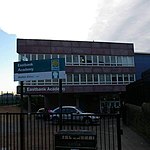Tollcross, Glasgow
1897 establishments in Scotland2014 Commonwealth Games venuesAreas of GlasgowBotanical gardens in ScotlandCategory B listed buildings in Glasgow ... and 8 more
Culture in GlasgowGardens in GlasgowGlass architectureGreenhouses in the United KingdomParks and commons in GlasgowShettlestonTypes of gardenUse British English from May 2015

Tollcross (Scottish Gaelic: Toll na Croise) is an area north of the River Clyde in Glasgow and has a popular park, opened in 1897, which is famed for its international rose trials. It lies approximately a mile east of the neighbouring suburb of Parkhead, and just north of Braidfauld and south of Shettleston.
Excerpt from the Wikipedia article Tollcross, Glasgow (License: CC BY-SA 3.0, Authors, Images).Tollcross, Glasgow
Ardfern Street, Glasgow Tollcross
Geographical coordinates (GPS) Address Nearby Places Show on map
Geographical coordinates (GPS)
| Latitude | Longitude |
|---|---|
| N 55.8437 ° | E -4.1719 ° |
Address
Ardfern Street
Ardfern Street
G32 8FF Glasgow, Tollcross
Scotland, United Kingdom
Open on Google Maps




